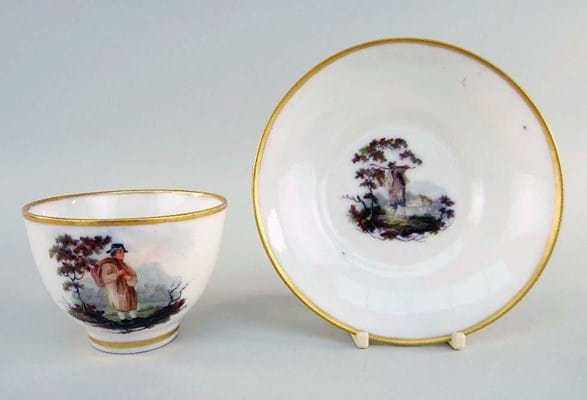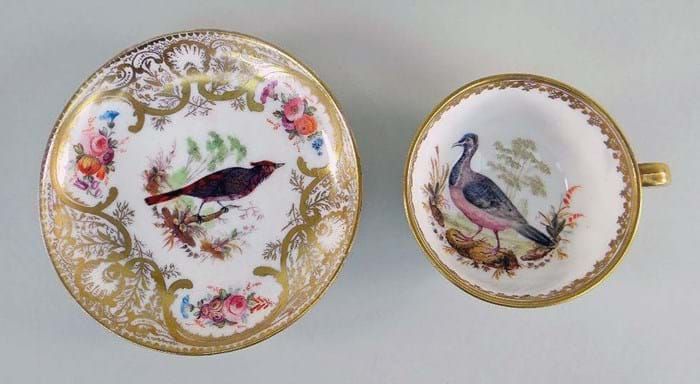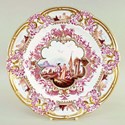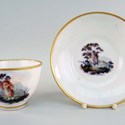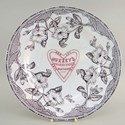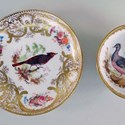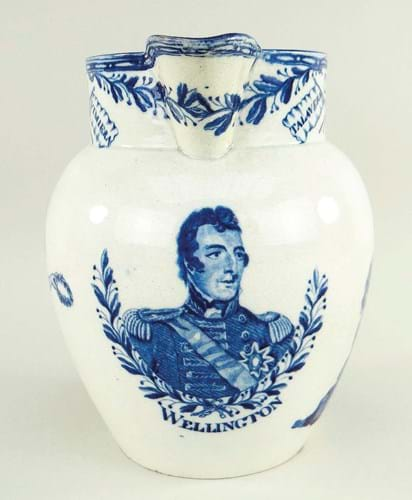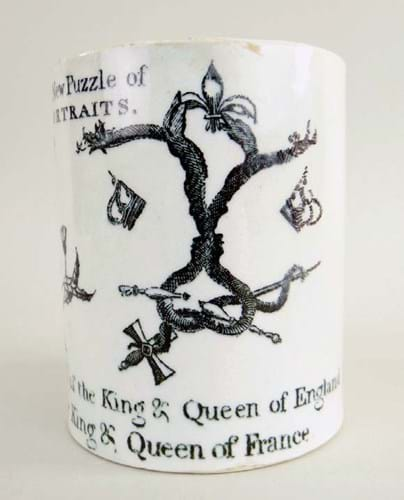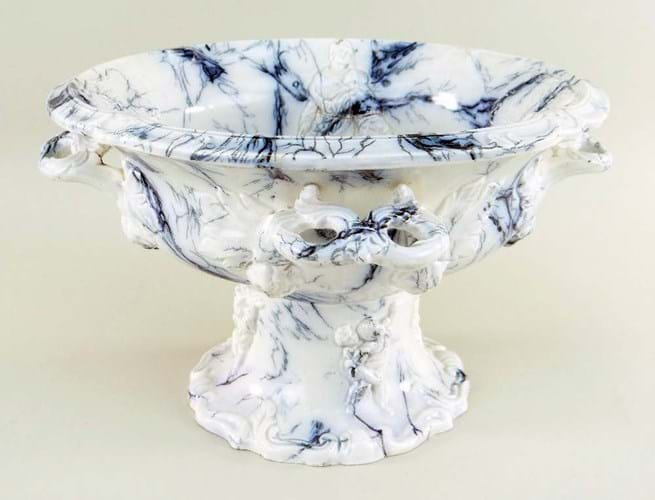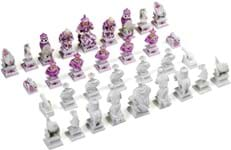Including both pottery and porcelain, some pieces were of a documentary nature (many jugs and plates had names and dates) and had been pictured in books on the subject. The collection realised £38,000.
The choice porcelain entry, sold at the lower end of a £3000-5000 guide at the December 5 sale, was a Nantgarw plate, c.1820, lavishly decorated with seven landscape vignettes in the style of the early 18th century Meissen decorator Johann Gregor Höroldt.
Similar to another plate in the National Museum of Wales, Cardiff, it was probably decorated in London at the Sims workshop, at a time when genuine Meissen pieces were much in demand.
Many Nantgarw pieces were cabinet wares sold by deluxe retailers.
A Nantgarw trio decorated in the early- Sèvres style with borders of turquoise and colourful floral sprays sold at £1000 while a tea cup and saucer of the Mackintosh service type took £850.
The latter, decorated with British birds in their habitat, was commissioned by the Priest Richards family of Plâs Newydd near Cowbridge and passed by descent to the Mackintosh clan of Moy Hall, Inverness. It was probably decorated in London by Robbins & Randall of Islington, with similar sets retailed at the time by Mortlock’s.
The key figure in the history of the Nantgarw factory is William Billingsley (1758-1828), who took his own porcelain recipes and lifetime’s experience in the ceramics industry to the Taff Valley in 1813.
He also worked alongside the ceramicist Lewis Weston Dillwyn of the Cambrian Pottery of Swansea, where an annexe was built for experimental soft paste porcelain production from late 1814-17. At Rogers Jones a rare Swansea porcelain cup and saucer in a glassy paste decorated by Billingsley with vignettes of a countryman in landscape sold at £950.
Made at much the same time was a 6in (16cm) high Dillwyn & Co pottery jug marking the battle successes of the Duke of Wellington. As well as a blue transfer print of the Iron Duke and allegorical portraits of Britannia and Victory, ribbons reference victorious battles of the Napoleonic Wars. It sold, with a slight chip to the foot, at £1650 (estimate £300-500).
Maritime minded
Naval-themed wares were the stock in trade of the Swansea potteries.
A typical 10in (25cm) ship plate, c.1800, with a manganese (rather than the usual blue or black) transfer print of a single-masted ship in full sail sold at £540. It was marked for the Cambrian factory – the earlier incarnation of the Dillwyn enterprise.
Another Cambrian rarity was a pearlware ‘illusion’ mug transfer printed in black with two portrait puzzles – one depicting the profiles of Louis XVI and Marie Antoinette surrounded by symbols of discord and destruction, and beside them George III and Charlotte with a radiant crown and the symbols of union. Based on an engraving, c.1794, the inscription reads A New Puzzle of Portraits Striking Likenefses of the King & Queen of England and the late King & Queen of France.
Essex auction house Sworders sold one of these in better condition for £820 in 2013. This example, broken and restored, made £260.
Cornish trade
An abundance of early Swansea pottery was commissioned or sold to Cornish families. A blue-edged pearlware plate of typical form dedicated to Wm Lukey 1788 is probably among them as the unusual surname is one that features in the Breage Parish of south-west Cornwall. Last sold at Dreweatt Neate in 2005, here it took £1400.
Two of the strongest prices in the sale were paid for Ynysmeudwy pottery.
Sold at £2100 was an 11 x 7in (27 x 17cm) Lazuli pattern baptism basin made shortly after the kilns opened on the Swansea Canal in 1848. Moulded with cherubs to the base and acanthus handles, to the interior are opposing Biblical reliefs (a depiction of Naomi and her daughters-in-law) interspersed with plaques inscribed Baptising Basin for Pantteg Chapel Presented by Mary Griffiths.
It is thought that local industrialists commissioned such bowls (another is in Neath Museum), with this one inscribed for a chapel in the village of Ystalyfera just three miles from the factory. Griffiths is believed to have been a local school teacher. In perfect condition, it was guided at £500-1000.
This piece is that pictured in the factory biography Ynysmeudwy & the Williamses by Mike Trew (2016) as is a later 19th century plate printed with trailing convolvulus and centred by the logo of Huzzey’s Swansea Valley Brewery. It is accompanied by an obituary from the London Gazette (July 12, 1861) for the ‘Brewer, Malster, Corn Factor, and Beer Retailer William Huzzey’.
Estimated at £150-250, it sold for £600 in Cardiff.



